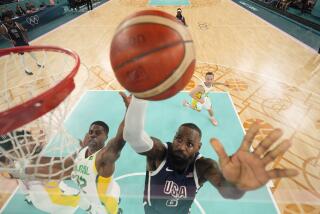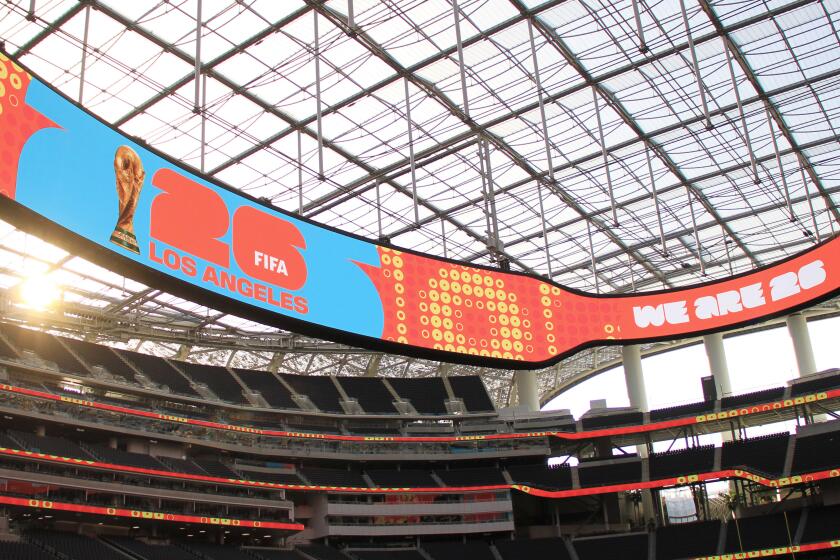No More Easy Marks for U.S.
PROVIDENCE, R.I. â April Heinrichs was standing behind the metal barricade that separates interviewers from interviewees in FIFAâs infamous âmedia mixed zoneâ -- this one in Columbus, Ohio -- on Sunday evening.
âIt wasnât easy,â the United States coach insisted after her teamâs 3-0 victory over North Korea. âThatâs the great thing about world-class athletes. Sometimes they make it look easy. It wasnât easy.â
For the record:
12:00 a.m. Oct. 1, 2003 For The Record
Los Angeles Times Wednesday October 01, 2003 Home Edition Main News Part A Page 2 1 inches; 46 words Type of Material: Correction
Soccer -- A chart of the Womenâs World Cup bracket was incorrect in Sports on Tuesday. The winner of the United States-Norway quarterfinal game will play the winner of Germany-Russia, not the winner of China-Canada, in the semifinals. The corrected schedule appears in todayâs Sports section.
Truth be told, however, it was easy, not only for the U.S. but for every one of the eight teams that has advanced to the quarterfinals of the fourth FIFA Womenâs World Cup.
The U.S. was in the so-called âGroup of Death,â supposedly the toughest of the four first-round groups in the 16-nation tournament, but it won all three of its games, outscoring opponents, 11-1.
Germany, possibly the most serious threat to U.S. hopes of retaining its world championship, also swept its first-round matches, scoring 13 goals and allowing only two.
In all, the eight teams that reached the quarterfinals lost only four matches, each one a defeat of the second-place team by the group winner.
The closest thing to an upset in the tournamentâs first 24 games was Australiaâs 1-1 tie with China, the 1999 runner-up.
None of the teams knocked out in the first round -- Argentina, Australia, France, Ghana, Japan, Nigeria, North Korea and South Korea -- were highly regarded. North Korea was seen as a possible dark horse, but faded badly in the stretch.
Now, the quadrennial world championship has reached the knockout phase, with two quarterfinal matches set for Foxboro, Mass., on Wednesday and two more in Portland, Ore., on Thursday.
Just like that, easy turns into difficult.
Each of the four games offers a different scenario, but the one circled in red on the calendar is Wednesday nightâs clash between the reigning world champion U.S. and former world champion Norway, the only team with a winning record against the Americans.
After Norway had struggled to beat France and had been thrashed, 4-1, by Brazil -- and before it, in turn, routed South Korea -- Heinrichs offered this comment:
âIâm sure the Norwegians are back there at home thinking, âWeâre sandbagging; everyoneâs starting to write us off.â Not April Heinrichs. April Heinrichs would never write those Norwegians off. They are so good.â
Heinrichs has purposely mixed and matched her starters, giving at least half the roster additional rest because the Norwegians will have had three daysâ rest to the Americansâ two.
The last time the teams met on this lofty a stage was in the gold-medal game at the Sydney Olympics in 2000, when the Norwegians won, 3-2, in overtime.
âWe seem to play the U.S. a lot in big situations and we like that,â Norwayâs Coach Age Steen told FIFAworldcup.com. âWe wanted to meet the U.S. a little later in the tournament, but we have to play them now, so thatâs how it is.â
The U.S. had been hoping to have defender Brandi Chastain back for the quarterfinals or semifinals, but now it appears that she will miss both. She remains on crutches after breaking a bone in her right foot in the opener.
If the U.S. does get past Norway, it figures to run smack into Germany in the semifinals in Portland.
Coach Tina Theune-Meyerâs team has what appears to be the easiest of the quarterfinal assignments. Germany plays Russia, a team that not only looked slow and ponderous in its loss to China on Sunday night but also has no pedigree of success at this level.
Germany has lost two players to injury, one the influential defender Steffi Jones, but it still has an 8-0-2 all-time record against Russia, with a 29-2 advantage in goals.
Striker Birgit Prinz, for one, is not worried.
âI think we have a serious chance to win this World Cup,â she said.
The most intriguing of the quarterfinals is Brazilâs game against Sweden on Wednesday afternoon. The South American champions are the youngest team in the tournament, but they have produced some of the most sparkling displays, not least of which was the rout of Norway.
With Katia going toe to toe with Germanyâs Prinz to become the tournamentâs top goal scorer -- each has scored four -- and with 17-year-old Marta threatening to steal the show each time she steps on the pitch, Brazil could improve on its third-place finish of four years ago.
But Sweden, in strikers Hanna Ljungberg and Victoria Svensson, has a potent one-two punch for the knockout phase.
A quarterfinal that may be the closest matchup is between Canada and favored China. Neither team has been impressive, but both can play smooth, flowing soccer.
Meanwhile, the tournamentâs first phase drew to a close amid unimpressive numbers. The dramatic crowds of 1999 are absent, and the U.S. is drawing best with an average crowd of 29,508 for its first three matches.
Similarly, television ratings have been poor -- not surprising considering the popularity of the sporting events it is going up against in the fall season. Sundayâs U.S. victory over North Korea produced an overnight rating of 1.8. Each rating point represents about 735,000 television homes.
The rating was 38% higher than for the Americansâ match against Sweden a week earlier.







